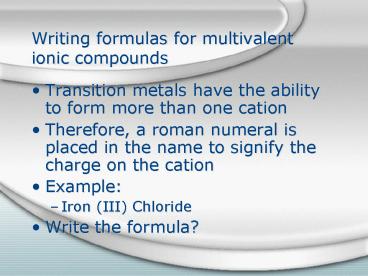Writing formulas for multivalent ionic compounds - PowerPoint PPT Presentation
1 / 15
Title:
Writing formulas for multivalent ionic compounds
Description:
Writing formulas for multivalent ionic compounds. Transition metals have the ... Naming compounds with multivalent metals. Deducing the roman numeral ... – PowerPoint PPT presentation
Number of Views:285
Avg rating:3.0/5.0
Title: Writing formulas for multivalent ionic compounds
1
Writing formulas for multivalent ionic compounds
- Transition metals have the ability to form more
than one cation - Therefore, a roman numeral is placed in the name
to signify the charge on the cation - Example
- Iron (III) Chloride
- Write the formula?
2
(No Transcript)
3
(No Transcript)
4
Writing formulas for mulitvalent ionic compounds
- Write formulas for the following
- Copper (I) Oxide
- Copper (II) Oxide
- Answers - Cu2O CuO
5
Naming compounds with multivalent metals
- If the metal is in group B it requires a roman
numeral in the name. - You will have to deduce the roman numeral based
on the formula. - Example
- Name CoI2
- Answer - Cobalt (II) Iodide
6
Naming compounds with multivalent metals
- Deducing the roman numeral
- Multiply the charge on the anion by the number of
anions and then divide by the number of cations
to get the roman numeral. - Write the names for Fe2S3 SnO2
- Answers -
- Iron (III) Sulfide Tin (IV) Oxide
7
- Take ten minutes and work on sections 5 and 6 on
the back side of your worksheet.
8
Polyatomic Ions
- A group of atoms that carry a charge
- Examples
- SO42- NO31-
- Names of polyatomic ions that contain oxygen will
end in -ate or -ite - -ite is one less oxygen then ate
- Example
- Sulfate is SO42- Sulfite is SO32-
- Chlorate is ClO31- Chlorite is ClO21-
- Other polyatomic ions
- NH41 Ammonium CN1- cyanide
- OH1- Hydroxide
9
Writing formulas using polyatomic ions
- The polyatomic ion is treated as one unit.
- Balance the charges
- Place parenthesis around the polyatomic ion if
there is more than one - Example
- Write the formula for Iron (II) Nitrate
- Fe2 and NO31- combines to make
- Fe(NO3)2
10
Naming using Polyatomic ions
- Name the metal than name the polyatomic ion. If
you need a roman numeral include it. - Treat the polyatomic ion as one unit (as if it
were one atom) - Example - Name CuSO4
- Copper (II) Sulfate
11
Exceptions for roman numerals
- Silver, Cadmium and Zinc do not get roman
numerals. - Ag is always 1, Cadmium and Zinc are always 2
- Tin and Lead need roman numerals. They are
multivalent (multiple oxidation states)
12
Naming Acids
- Memorize
- HCl - Hydrochloric Acid
- H2SO4 - Sulfuric Acid
- HNO3- Nitric Acid
- H3PO4 - Phosphoric Acid
- Note - Acids give off H1 (Hydrogen ions) and
bases give off OH1- ions - What do you get when an acid and base combine?
13
(No Transcript)
14
Check for understanding
- Name or write the formula for
- Potassium Sulfate
- Chromium (III) Cyanide
- Fe(ClO3)3
- CuCl
- Answers
- K2SO4 Cr(CN)3
- Iron (III) Chlorate
- Copper (I) Chloride
15
- Now finish your worksheet and work on your
homework. - Get help
- Make sure and check your answers on-line. You
will be writing formulas all year and doing math
based on these formulas. You get the formula
wrong you get the math wrong.































